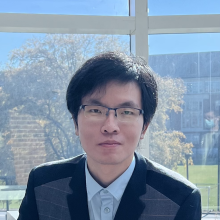-
Title
Postdoctoral Research Staff Member -
Email
su10@llnl.gov -
Phone
(925) 424-3264 -
Organization
PLS-AEED-ATMOSPHERIC, EARTH, ENERGY
RESEARCH INTERESTS:
My research is deeply rooted in the study of convection within the planetary boundary layer (PBL), quintessential examples of chaos in our real world. This chaotic PBL system is inherently linked with clouds and the Earth's surface. I perceive the interactions between clouds and land not as isolated phenomena but as parts of a cohesive system, with the PBL serving as the essential medium facilitating their dialogue. PBL turbulence can catalyze this coupling process and induce rapid and seemingly random vertical movements of aerosols and water vapor within this coupled system. By investigating coupling processes between clouds, PBL, and the land surface, my goal is to illuminate the role of PBL in the climate system, urbanization effects, and air pollution formation.
My research employs multi-scale modeling tools, including Large-Eddy Simulations and Global Storm-Resolving Models (i.e., Kilometer-Scale Climate Models), alongside advanced remote sensing technologies like lidar and radar, complemented by cutting-edge deep learning methodologies. Building on this overarching goal of understanding the integrated cloud-PBL-surface system, I have developed several interconnected research topics, including:
(1) Remote Sensing of PBL and Clouds
(2) Mechanisms of Land-PBL-Cloud Coupling
(3) Representation of PBL and Clouds in Multi-scale Models
(4) Deep Learning Driven Simulation of PBL and Clouds
(5) Aerosol-PBL-Cloud Interactions
The full list of these research works can be found in Google Scholar.
Professional Activities & Service:
-
Panelist, NASA ROSES Panel review; Reviewer for proposals of NASA and NSF
-
Reviewer for 23 Peer-reviewed journals (Total reviews: 107)
-
Co-organizer and Committee Member for the 9th COAA International Conference
-
Guest Editor for Remote Sensing and Atmosphere
-
Primary Organizer for the Special Issue, Remote Sensing of Aerosols, PBL, and Clouds
-
Member: American Geophysical Union; American Meteorological Society
Ph.D., Atmospheric Sciences, University of Maryland, College Park, USA
B.S., Atmospheric Sciences, Peking University
My research, centered on Planetary Boundary Layer, explores its interactions with clouds, aerosols, and land. I wish to offer a comprehensive view of its role in the climate system through a series of publications. (Google Scholar) (†supervised student, *corresponding author, +co-first author)
- Su, T. and Zhang, Y. 2024. Deep Learning Driven Simulations of Boundary Layer Cloud over the US Southern Great Plains. Geoscientific Model Development
- Roldán, N.†, Su, T.*, Li, Z.* 2024. Refining Planetary Boundary Layer Height Retrievals from Micropulselidar at Multiple ARM Sites Around the World. JGR: Atmospheres
- Zhang, H., Su, T.* et al. 2024. First assessment of cloud-land coupling in LASSO Large-Eddy Simulations Geophysical Research Letters
- Su, T. et al. 2024: Constraining Effects of Aerosol-Cloud Interaction by Accounting for Coupling between Cloud and Land Surface. Science Advances
- Su, T. and Zhang, Y. 2024: Deep-Learning-derived Planetary Boundary Layer Height from Conventional Meteorological Measurements. ACP
- Su, T. et al. 2024: Observation and Reanalysis Derived Relationships Between Cloud and Land Surface Fluxes Across Cumulus and Stratiform Coupling Over the Southern Great Plains. Geophysical Research Letters [Link] (DOE ASR Highlight)
- Su, T. and Z. Li, 2024: Decoding the dialogue between clouds and land, Eos [Link] (DOE ASR Highlight)
- Su, T., Li, Z., Zheng, Y, 2023. Cloud-surface coupling alters the morning transition from stable to unstable boundary layer. Geophys. Res. Lett. [Link] (DOE ASR Highlight)
- Su, T., Li, Z., Zheng, Y., Wu, T., Wu, H., and Guo, J, 2022. Aerosol-boundary layer interaction modulated entrainment process. npj Climate and Atmospheric Science. [Link] ( DOE ASR Highlight)
- Su, T., Zheng, Y. and Li, Z, 2022. Methodology to determine the coupling of continental clouds with surface and boundary layer height under cloudy conditions from lidar and meteorological data. Atmos. Chem. Phys. [Link] (Highlight in DOE ARM Annul Report; DOE ASR Highlight)
- Su, T., Li, Z. and Kahn, R, 2020. A new method to retrieve the diurnal variability of planetary boundary layer height from lidar under different thermodynamic stability conditions. Remote Sensing of Environment. [Link] [Dataset]
- Su, T. et al, 2020. The significant impact of aerosols vertical structure on lower-atmosphere stability and its critical role in aerosol-PBL interaction. Atmos. Chem. Phys. [Link] (DOE ASR Highlight)
- Su, T. et al, 2020. Abnormally shallow boundary layer associated with severe air pollution during the COVID‐19 lockdown in China. Geophysical Research Letters. [Link]
- Su, T., Laszlo, I., Li, Z., Wei, J. and Kalluri, S, 2020. Refining aerosol optical depth retrievals over land by constructing the relationship of spectral surface reflectances through deep learning: Application to Himawari-8. Remote Sensing of Environment. [Link] (UMD Highlight)
- Su, T., Li, Z. and Kahn, R, 2018. Relationships between the planetary boundary layer height and surface pollutants derived from lidar observations over China: regional pattern and influencing factors. Atmos. Chem. Phys. [Link] (UMD Highlight)
- Su, T. et al., 2017. An intercomparison of long-term planetary boundary layer heights retrieved from CALIPSO, ground-based lidar, and radiosonde measurements over Hong Kong. J. Geophys. Res. Atmos. [Link]
- Su, T. et al., 2017. An intercomparison of AOD-converted PM2.5 concentrations using different approaches for estimating aerosol vertical distribution. Atmos. Environ. [Link]
- Su, T. et al., 2017. The Evolution of Springtime Water Vapor Over Beijing Observed by a High Dynamic Raman Lidar System: Case Studies. IEEE Journal of Selected Topics in Applied Earth Observations and Remote Sensing. [Link]
- Guo, J. +*, Su, T. +*. et al. 2019. Declining Summertime Local‐Scale Precipitation Frequency Over China and the United States, 1981-2012: The Disparate Roles of Aerosols. Geophys. Res. Lett. [Link]
- Guo, J.*, Su, T.*, et al. 2017. Declining frequency of summertime local-scale precipitation over eastern China from 1970 to 2010 and its potential link to aerosols. Geophys. Res. Lett. [Link]
Charles Caramello Distinguished Dissertation Award, UMD, 2022
AOSC Best Dissertation Award, UMD, 2021
Ann G. Wylie Dissertation Fellowship, UMD, 2021
Best Student Oral Presentation, 100th AMS Annual Meeting, 2020
Helmut Landsberg Outstanding Peer Reviewed Publication Award, UMD, 2020
Graduate School Summer Fellowship, UMD, 2020
Green Fund Award, UMD, 2019
Dean’s Fellowship, UMD, 2016


